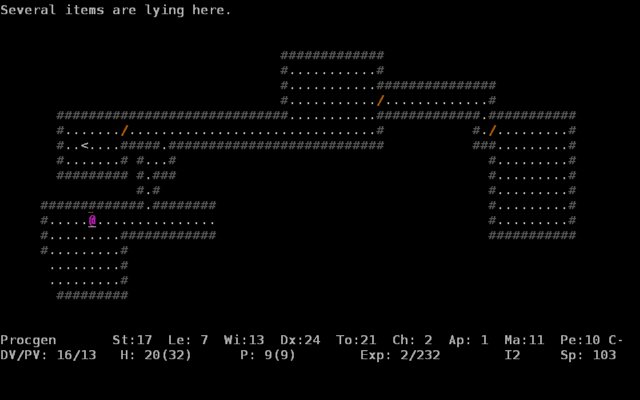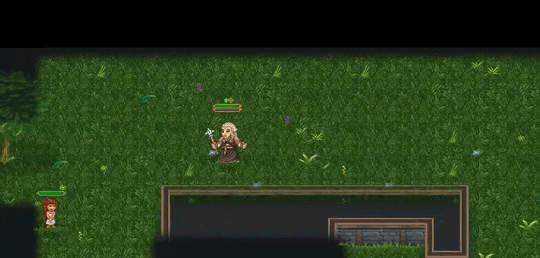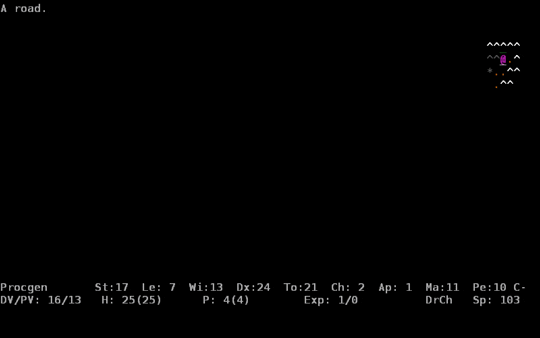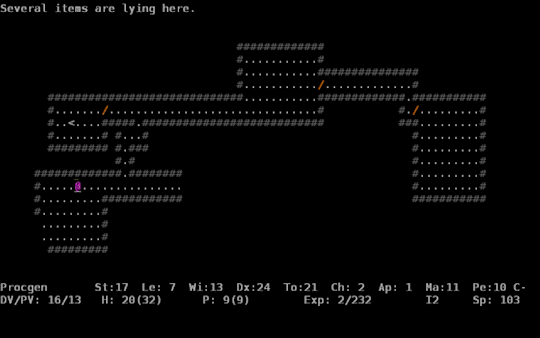

Ancient Domains of Mystery
ADOM is one of the big five roguelikes of the Usenet era, and even back then it stood out as something a bit different.
While the other games were open-source and developed by teams, ADOM has always been the personal project of Thomas Biskup. It has a mostly-fixed overworld, populated by a series of different (sometimes wildly different) dungeons.
Since it’s been in development for over twenty years at this point, it’s dense with features. It’s got dungeon plants that grow according to Conway’s Game of Life. Key skills include food preservation, literacy, and bridge building. There’s a key to wipe your face, and you may find yourself needing it.

ADOM has more story than most roguelikes, with lots of quests and special locations with their own rules for dungeon generation…

…though good luck asking people about it when you’re a corrupted Chaos Knight with tentacles instead of a mouth.
The main quest is to deal with the source of Chaos that’s somewhere deep beneath the mountain range, but there’s dozens of different dungeons to explore.
The overworld-with-different-dungeons design allows the game to explore a lot of different approaches to generating levels. Many of the places are semi-optional, giving players a way to manage their own risk. A few interesting ones:
- The cave where monster generation is scaled to the player’s experience level, so it’s easy-ish a low levels and nearly impossible at high levels…and there’s a second dungeon that can only be accessed by passing through the cave.
- Most of the dungeons are persistent, and stay the same once generated. The exception is the optional “infinite dungeon” which will generate a new level each time you use the stairs.
- The Tower of Eternal Flames uses the usual generation rules, but adds the twist that the environment is very, very hot and requires the player to take precautions against the heat.
This combination of a mostly-fixed overall progression and a highly variable emergent experience has given ADOM some dedicated fans. Many roguelikes have similar structures, though ADOM takes it much further than most, with the gradual discovery of the fixed quests being an important part of learning the game.
And, of course, there’s the depth that twenty years of development can bring. Rather than making everything procedural and unpredictable, ADOM takes advantage of the structure of the fixed features. That’s why cats are significant, deciding whether to get the water-proof blanket is a strategic choice, beeswax is occasionally vital, and rescuing the small dog is a challenge.

Most of the large-scale variation is instead found in the characters themselves. Summoners play very differently from Elementalists. The relatively sophisticated inventory model includes details like not being able to put on or take off rings if you’re wearing gloves–which can, of course, be cursed so you can’t remove them–and similar nuances. With skills, talents, a star sign, and a procedurally generated backstory, each character is unique.
The graphics were originally all in the traditional ASCII character mode, but a tile-based mode has been added since the return to active development a few years ago.
Like other roguelikes of the Usenet era, ADOM was freely downloadable, but the developer requested that players send him a postcard. He’s still getting them, and has apparently got quite a collection now.
These days, development of ADOM is supported by the Deluxe version, which is available on Steam and has a number of additional features (including a non-permadeath mode), though the Classic postcard-supported version is still available.
